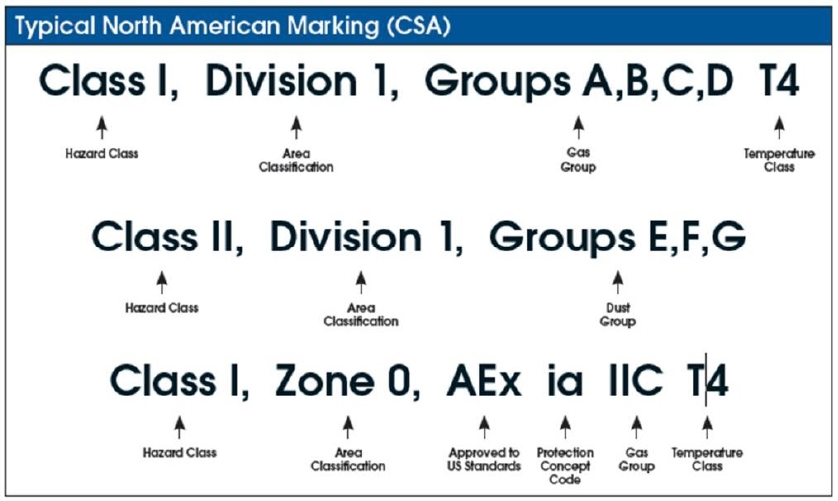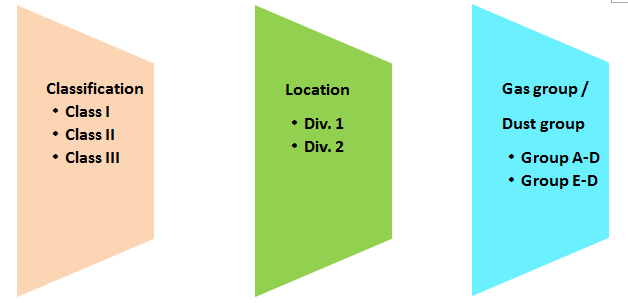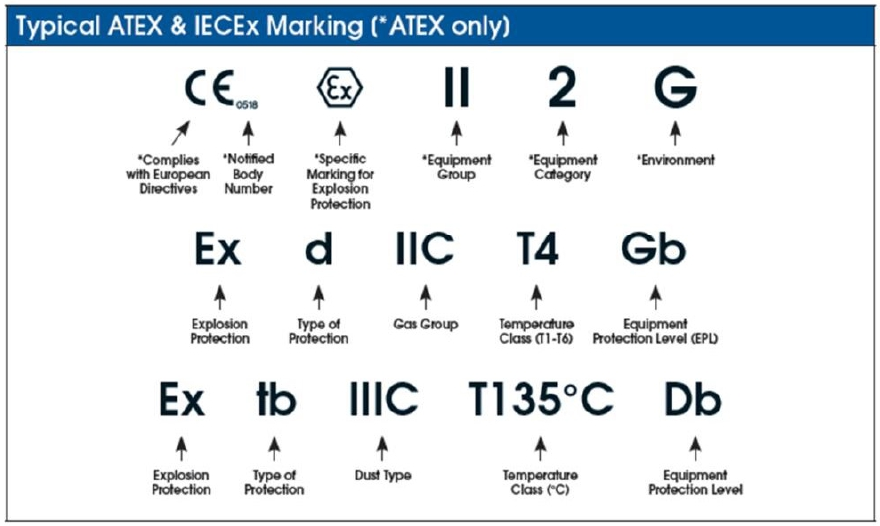This article mainly explains the global explosion-proof mark and explosion type, including the North American division system explosion-proof mark, Europe and the international zone system explosion-proof mark, it is not only suitable for explosion-proof lamps, but also for other explosion-proof equipment products.
Note: This article is authoritatively published by CESP Explosion-proof Technology Center, for reference only, if you have any contact, please contact us.
Typical North American Marking (CSA)

Definition of Hazardous Locations - North America

Classification of Regional Explosive classification
|
Class I ·Flammable gas, vaporization or liquid substance Class II ·Combustible dust |
Class I Division/Zone Area
Explosive gas application Location comparison table
|
Division 1 Flammable or explosive substances in a normal environment, or the presence of recurrent |
Zone 0 Flammable or explosive substances in a normal environment for a long time or continuous presence Zone 1 Flammable or explosive substances may be present in a normal environment |
|
Division 2 Flammable or explosive substances are extremely unlikely to exist in a normal environment |
Zone 2 Flammable or explosive substances are extremely unlikely to exist in a normal environment |
Class I Division/Zone
Explosive gas group classification table
|
Division 1 and 2 |
Zone 0, 1 and 2 |
|
A (acetylene) |
IIC (acetylene & hydrogen) |
|
B (Hydrogen) |
|
|
C (Ethylene) |
IIB (Ethylene) |
|
D (propane) |
IIA (propane) |
Class I Division/Zone
Explosive dust group classification table
|
Division 1 and 2 |
Zone 20, 21 and 22 |
|
Metal dust |
IIC (Carbonaceous dust) |
|
F (Carbonaceous dust) |
IIB (Non-conductive dust) |
|
G (Non-conductive dust) |
IIB (Non-conductive dust) |
|
IIA (combustible flyings) |
|
Division |
||
|
Class I Explosive gas |
Group D |
Gas (coal mine) |
|
Group D |
Propane |
|
|
Group C |
Ethylene |
|
|
Group B |
Hydrogen |
|
|
Group A |
Acetylene |
|
|
Class II Explosive dust |
Group E |
Metal Dust |
|
Group F |
Black charcoal /Coal/Coke Dust |
|
|
Group G |
Grain dust |
|
|
Class III flyings |
||
Division System (Class II & Class III Dust)
|
Explosion-proof type |
Mark |
Location |
|
Dust Ignition Proof Dust Protected Pressurisation Pressurisation Intrinsic Safety |
DIP NI PX PY PZ IS |
Class II Division 1 Division 2 Division 1 Division 2 Division 1 |
|
Fiber & Flying Protection |
- |
Class III Division 1 & 2 |

|
International - Zone |
|
|
Group I - Coal mine gas environment |
|
|
Group II Explosive atmospheres other than coal mines |
IIA Propane |
|
IIB Thylene |
|
|
IIC Hydrogen + Acetylene |
|
|
Group III Explosive dust environment other than coal mines |
IIIC Conductive dust |
|
IIIB Non-conductive dust |
|
|
IIIA Flammable flyings |
|
|
North American Zone system |
ATEX |
IECEx |
ATEX |
Operating conditions |
|
Ma |
Ma |
Ma |
M1 |
The device still operates when an explosive environment occurs |
|
Mb |
Mb |
Mb |
M2 |
When an explosive environment is present, the device is powered off |
|
Ga |
Ga |
Ga |
1G |
Still running in Zone 0/1/2 |
|
Gb |
Gb |
Gb |
2G |
Still running in Zone 1/2 |
|
Gc |
Gc |
Gc |
3G |
Still running in Zone 2 |
|
Da |
Da |
Da |
1D |
Still running in Zone 0/1/2 |
|
Db |
Db |
Db |
2D |
Still running in Zone 21/22 |
|
Dc |
Dc |
Dc |
3D |
Still running in Zone 22 |
Note: the North American Division system does not have the concept of EPL equipment protection level
Zone System(Gas)
|
Explosion-proof Type |
Mark |
Equipment Protection Level |
|
Intrinsic safety ”i” Encapsulation ”m” |
Ex ia Ex ma |
Ga Ma Ga Ma |
|
Flame Enclosure ”d” Intrinsic safety ”i” Increase safety ”e” Pressurized ”p” Oil immersion ”o” Encapsulation ”m” Power Filling ”q” |
Ex d Ex ib Ex e Ex px Ex py Ex o Ex mb Ex q |
Gb Mb Gb Mb Gb Mb Gb Mb Gb Mb Gb Mb Gb Mb |
|
Intrinsic safety ”i” ”n” Type Encapsulation ”m” |
Ex ic Ex nL Ex nA ExnC Ex nR Ex mc |
Gc Gc Gc |
Zone System(Dust)
|
Explosion-proof Type |
Mark |
Equipment Protection Level |
|
Dust Ignition Protection by Enclosure ”ta” Intrinsic safety ”i” Encapsulation ”m” |
Ex ta Ex ia Ex ma |
Da Da Da |
|
Flameproof Enclosure ”tb” Intrinsic safety ”i” Pressurized Enclosure ”p” Encapsulation ”m” |
Ex tb Ex ib Ex p Ex mb |
Db Db Db Db |
|
Dust Ignition Protection by Enclosure ”tc” Intrinsic Safety ”i” Encapsulation ”m” |
Ex tc Ex ic Ex mc |
Dc Dc Dc |
|
Zone System Group II |
Division System Class I |
Maximum surface temperature / ⁰C |
|
T1 |
T1 |
450 |
|
T2 |
T2 |
300 |
|
T2A |
280 |
|
|
T2B |
260 |
|
|
T2C |
230 |
|
|
T2D |
215 |
|
|
T3 |
T3 |
200 |
|
T3A |
180 |
|
|
T3B |
165 |
|
|
T3C |
160 |
|
|
T4 |
T4 |
135 |
|
T4A |
120 |
|
|
T5 |
T5 |
100 |
|
T6 |
T6 |
85 |
Note: The Max. surface temperature of Zone Group I is 150⁰C or 450⁰C.

